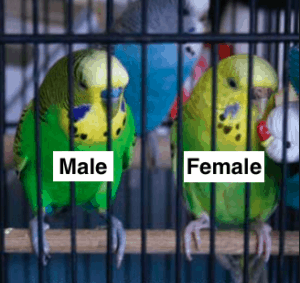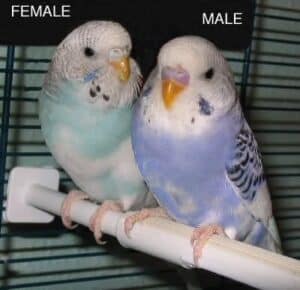Hello there, fellow bird lovers!
If you’ve ever been curious about how to tell the gender of your beloved parakeet, you’ve come to the right place.
In this article, I’ll share with you the 9 best methods to easily determine whether your feathered friend is a male or a female.
No more guessing games!
Let’s dive right in and discover the secrets to identifying the gender of your adorable parakeet.
How to Tell the Gender of a Parakeet?
There are various methods that you can use to tell the gender of a parakeet, and some of them are more accurate than others.
However, if you have an adult parakeet that is non-pigmented or ambiguously pigmented, then more stressful methods like DNA or endoscopic sexing may be required.
You can take the following steps to determine your parakeet’s gender,
1. The Age of Your Parakeet
It is hard to distinguish between male and female parakeets if they are young (under one year of age).
However, the feathers of both genders become more distinct as they grow—one way to tell how old your parakeet is to check its eyes.
Young parakeets generally have deep black eyes until four months of age.
Once they are eight months old, the irises become dark gray or brown, and, turning one year of age, the irises become light gray or brown.
It is what a parakeet’s aging process is.
2. The Color of Your Parakeet Cere

You can also check the cere of your parakeet to determine its gender.
Generally, the male parakeets have cere that is either purplish-blue, pink, or blue.
At the same time, the female parakeet cere is either light tan, white, or light blue.
3. The Color of Your Parakeet Feet

It is easy to determine the age of your parakeet, especially if it is one year old, by analyzing its legs and feet.
Adult male parakeets older than one year usually have bright blue color legs resembling their cere.
At the same time, female parakeets over the age of one year have pink or brown legs.
4. Head and Body of your Parakeet

External appearances and physical structure differences between male and female parakeets closely relate to sexual dimorphism.
Mature and healthy male parakeets have a bigger size and more weight than female parakeets.
Male parakeets also have a larger physical structure and are stronger than female parakeets.
Pairing them side by side, the parakeet gender with a larger head is male.
Moreover, male parakeets often have more vibrant color feathers than female parakeets.
5. The Noise Level
Parakeets are among the loudest pet birds in the parrot family.
Happy parakeets usually sing, talk, or mimic sounds they hear.
Male parakeets are significantly noisier than female parakeets.
Moreover, male parakeets also love singing songs or chirping for longer periods.
While female parakeets also make noise but it usually sounds less musical and angry.
If your parakeet makes a chattering noise, it is likely a male parakeet.
However, keep in mind that the parakeet’s behavior is not the only factor to take into consideration when determining its gender because both male and female parakeets can have the same behavior.
6. The Behavior of your Parakeet
Parakeets can communicate with humans or other birds in many ways.
If you are a new parakeet owner, the communication tactics of your feather friend can be confusing.
If you can properly read your parakeet’s behavior, it will be easy for you to put it in the right gender chart.
Male parakeets tap their beak against the cage or pop their head up and down.
At the same time, the female parakeet’s appearance may be more aggressive and bossy.
7. Identify your Parakeet’s Gender through its Color
The most critical thing when you want to know your parakeet’s gender is its appearance.
Telling whether your feathered friend is a male or female can be hard, especially if your bird pet is under the age of one year.
Sexual dimorphism usually refers to the size, external appearance, and physical structure that can be found in both sexes.
Identifying your parakeet’s gender through its appearance means you have to identify the physical differences of your parakeet.
Although identifying your parakeet’s gender through its appearance is the easiest way, it may not be the precise one.
Also, do bear in mind that feather coloration alone is not the only thing to determine the gender of a parakeet.
Usually, the male parakeet’s feathers are blue in color, while the female parakeet’s feathers can be green.
8. Identify Your Parakeet Gender through DNA
Using the DNA method to determine the gender of a parakeet is the most preferred method for those who want to breed parakeets.
This method also includes obtaining eggshell or feather samples to determine the gender of a parakeet.
This DNA testing kit is my recommendation.
You can buy this DNA kit from Amazon.
Your parakeet’s DNA samples also feature nucleated cells, meaning the blueprint of your parakeet’s DNA is already there.
The DNA cells of your parakeet are then extracted, amplified, and combined at a laboratory with DNA markers to detect whether the sample contains ZZ chromosomes or ZW chromosomes.
If the samples have ZZ chromosomes, it means your parakeet is male, and if they include ZW chromosomes, your parakeet is female.
After that, the DNA results are then sent back to the bird’s owner.
If you want to determine your parakeet’s gender through the DNA method, ensure that the feathers, eggshells, and blood are performed with extreme care.
Feather Sexing: Feather sexing, unlike blood sexing, is safer and less stressful.
However, you should know that instead of using fallen feathers, it requires freshly plucked feathers.
Eggshell Sexing: Eggshell sexting is far less stressful than both blood and feather sexting.
9. Identify your Parakeet Gender through Surgical Sexing (Endoscopic)
Another way that is used to tell the gender of a parakeet is endoscopic or surgical sexing.
In this method, your bird pet is placed under the anesthetic to insert an endoscope through the abdominal air sacs and the skin of your parakeet.
An endoscope contains fiber-optic imaging to visualize the internal organ structure of a bird.
While the air sacs are large air chambers with thin, transparent walls.
The endoscope visualizes the entire organ structure of your parakeet, including the reproductive organs of your pet.
If you are agreed to place your parakeet under an endoscope, the veterinarian can easily tell the gender of your parakeet.
This method is incredibly accurate and fast handled by a professional veterinarian.
Moreover, the endoscopic method also enables you to discover any other health issues of your bird pet.
However, you should also bear in mind that, unlike the DNA method, endoscopic sexing is more expensive and riskier to your parakeet’s health.
These health risks include internal organ trauma, rib fracture, air sac infection, internal abdominal cavity infection, hemorrhage, etc.
Conclusion
In conclusion, we have delved into the world of parakeet gender determination, exploring the 9 best methods to decipher whether your feathered companion is a male or female.
Armed with this knowledge, you can now confidently identify the gender of your parakeet, fostering a deeper understanding of their behavior and unique traits.
Remember, each method has its advantages and limitations, so it’s essential to combine multiple techniques for a more accurate result.
Whether it’s the cere color, behavior observations, or the tell-tale signs of specific mutations, these methods, when used in harmony, will empower you to unravel the mystery of your parakeet’s gender.
When I was just starting on my parakeet ownership journey, I recall an instance where I was utterly confused about my bird’s gender. No amount of reading or expert consultation seemed to help. It was only when Thomas (Who specializes in training by using shock collars for long-haired dogs) about a unique observation method he had employed that things clicked for me. His insights were a turning point, bridging the gap between textbook knowledge and real-life understanding.
Furthermore, respecting and understanding the differences between male and female parakeets will contribute to their overall well-being and happiness.
It will also aid in creating a harmonious environment within your aviary or household, ensuring a thriving and delightful relationship with your avian companion.
Now, as you continue on your journey of parakeet ownership, armed with the knowledge of gender identification, may you and your feathered friend embark on countless wonderful adventures together.
Cherish the bond you share, and let the beauty of your parakeet’s personality shine through.
Happy bird watching!
FAQ
Can I determine the gender of my parakeet by its color?
Yes, the color of the cere (the area just above the beak) can be a reliable indicator of a parakeet’s gender. In most species, males have a distinct blue or purplish cere, while females have a pink or brownish cere. However, there are exceptions for certain mutations, so it’s best to cross-reference with other methods.
Are there any behavioral differences between male and female parakeets?
Yes, male and female parakeets can exhibit slight behavioral differences. Generally, male parakeets are more vocal, outgoing, and prone to mimicking sounds, while females tend to be quieter and more focused on nesting behaviors. However, these traits can vary among individual birds, so it’s essential to consider other identification methods as well.
Can a DNA test provide a definitive answer on my parakeet's gender?
Yes, DNA testing is considered the most reliable method for gender identification. It involves collecting a small blood sample or feathers for analysis. DNA testing can determine the parakeet’s sex with 99.9% accuracy and is especially useful for visually similar or mutation-specific cases.
My parakeet's cere color seems to change. What does this mean?
The cere color in parakeets can change based on age, hormonal fluctuations, and breeding season. Young parakeets usually have pale cere, which gradually develops into its adult color as they mature. Hormonal changes during breeding can cause temporary shifts in cere color, making it more vibrant in males or darker in females.
Last Updated on September 30, 2023 by Lily Aldrin


I have a parakeet and I have a question about his cere. It was a light blue when I bought him a year ago and now it is turning brown. He is blue, but not a vibrant blue. His feet are pinkish white. Is he getting sick? Now I’m wondering if he is a she? He is active and doesn’t appear ill. Thank you so much for being here to help!
Bruh feather color doesn’t sex a budgie. In the wild, they are all green. In captivity they can be anywhere from all yellow, gray, purple, olive, black, and the most recognizable, blue. So that is utter nonsense.
I brought home 2 parakeets 2 days ago. I think the larger one is a male and the smaller one is a female. The male seems overly aggressive because he goes back and forth constantly on the perch and pecks at the female. She has no trouble getting food because there are enough feeders. Should I be worried?